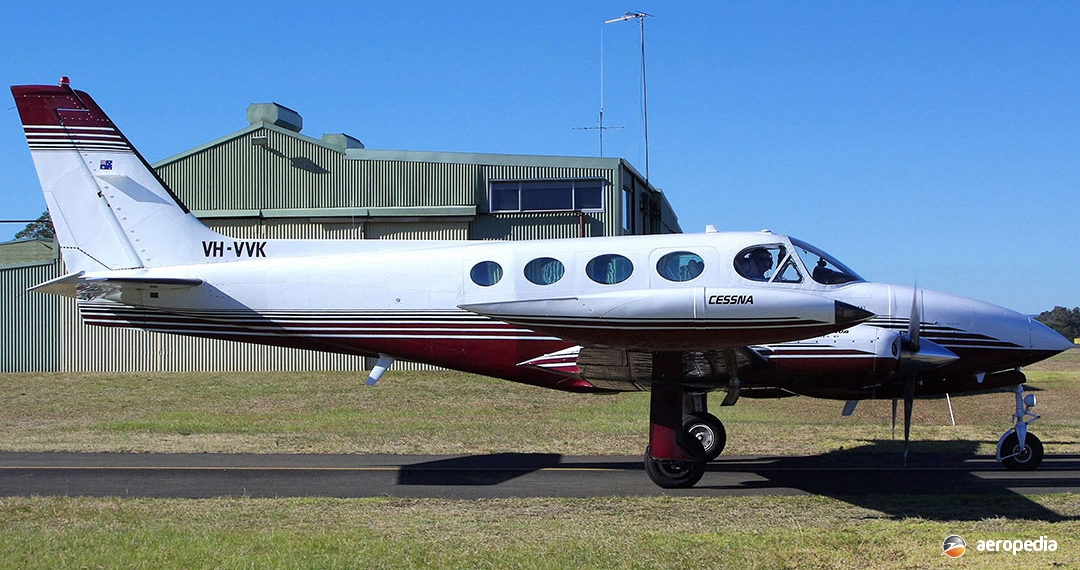Photograph:
Cessna 340A VH-VVK (c/n 340A0074) at Camden, NSW in July 2009 (David C Eyre)
Country of origin:
United States of America
Description:
Business and executive aircraft
Power Plant:
Two 213 kw (285 hp) Teledyne Continental TSIO-520-K six-cylinder horizontally-opposed air-cooled engines
Specifications:
- Wingspan: 11.62 m (38 ft 1 1/3 in)
- Length: 10.46 m (34 ft 4 in)
- Height: 3.83 m (12 ft 6 2/3 in)
- Wing area: 17.16 m² (184.7 sq ft)
- Max speed at sea level: 356 km/h (221 mph)
- Max speed at 4,877 m (16,000 ft): 418 km/h (260 mph)
- Max cruising speed at 3,048 m (10,000 ft): 352 km/h (219 mph)
- Max cruising speed at 6,096 m (20,000 ft): 388 km/h (241 mph)
- Initial rate of climb: 457 m/min (1,500 ft/min)
- Service ceiling: 8,077 m (26,500 ft)
- Range with no reserves at 346 km/h (215 mph) at 3,048 m (10,000 ft): 1,067 km (663 miles)
- Range with max auxiliary fuel at 6,096 m (20,000 ft): 2,373 km (1,475 miles)
- Empty weight: 1,689 kg (3,723 lb)
- Loaded weight: 2,710 kg (5,975 lb)
Development of the Cessna 340 series was initiated in 1969 but, because the prototype was lost during test flying in 1970, trials were delayed and deliveries of production aircraft did not commence until early in 1972. The Model 340 was evolved from the Model 310, and at the time of its introduction it was the first light twin-engine aircraft that was fully pressurised. This model introduced a new pressurised capsule-type fuselage of fail-safe design, using a new fuselage married to the wings and undercarriage of the larger and more powerful Model 414.
The Model 340 cabin featured a centre aisle and an airstair door. Models built prior to 1976 had 213 kw (285 hp) Continental engines, the same turbocharged engines as were fitted to the turbocharged Model 310. Later models were fitted with Continental engines which provided 231 kw (310 hp) for take-off. At the same time as the engines were changed, smaller diameter propellers were fitted to reduce propeller tip speeds and thus lower sound levels in the cabin. Luggage areas for 422 kg (930 lb) were located in the nose, behind the seats, and in a nacelle locker.
From 1975 two new models were added to the Cessna 340 range, the Models 340 II and the 340 III. These differed in the packages of avionics and instruments fitted. Later in 1979 the Model 335 was introduced as the lowest-priced, cabin-class, business twin. Powered by 224 kw (300 hp) Teledyne Continental fuel-injected TSIO-520-EB engines, it had a service ceiling of 8,169 m (26,800 ft) and a cruising speed at 75% power of 361 km/h (224 mph) at 3,048 m (10,000 ft). It had a range of 2,208 km (1,372 miles) at 312 km/h (194 mph) at 6,096 m (20,000 ft). Similar in appearance to the Model 340, the Model 335 was basically the Model 340 without pressurisation.
The Model 340A which was introduced in 1976 had two 230 kw (310 hp) turbocharged Continental fuel-injected six-cylinder engines driving three-blade constant speed McCauley propellers and had a max cruising speed of 425 km/h (264 mph).
Production of the 340 series took place between 1971 and 1984, and a total of 1,287 aircraft was built. The Model 335 was built between 1979 and 1981 but only 64 examples were built. Some 27 examples of the Model 340 have been registered in Australia but no Model 335s have been registered. No example of either model has been registered in New Zealand.

